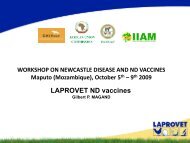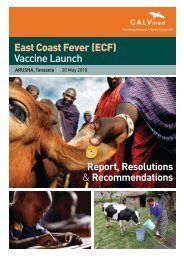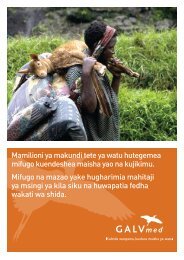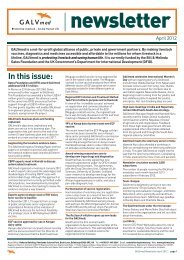A Path to Prosperity New Directions for African Livestock
GALVmed Impetus Strategy Paper
GALVmed Impetus Strategy Paper
- No tags were found...
Create successful ePaper yourself
Turn your PDF publications into a flip-book with our unique Google optimized e-Paper software.
3 The Competitiveness<br />
of Lives<strong>to</strong>ck Production<br />
<strong>African</strong> lives<strong>to</strong>ck production remains highly<br />
un-competitive in global terms. Several<br />
parameters reflect this:<br />
> Lives<strong>to</strong>ck yields are relatively low, <strong>for</strong> example:<br />
• Young weaned cattle gain no more than 50 kg<br />
per year in the transhumant system in West<br />
Africa, which means that it takes five or six<br />
years <strong>to</strong> produce a 250-kg animal 125 .<br />
• Sub-Saharan Africa records the lowest milk<br />
and meat production per animal (6.8 kg of meat<br />
and 24.8 kg of milk per animal per year in the<br />
mixed farming systems) 10 .<br />
> Prices are relatively high, <strong>for</strong> example:<br />
• Brazil exports chickens at a cost 25% below<br />
that of Senegal’s poultry industry, due <strong>to</strong> the<br />
competitiveness of its production stream, which<br />
has low labour and raw materials costs 22 .<br />
• Brazil, Argentina or Australia are able <strong>to</strong> ship<br />
beef carcasses <strong>to</strong> Africa at about US$1/kg<br />
(carcass price <strong>for</strong> the producer), which is 40%<br />
less than the going price in West Africa. 22<br />
> Import/export figures:<br />
• SSA accounts <strong>for</strong> less that 2% of globally traded<br />
lives<strong>to</strong>ck products.<br />
• <strong>African</strong> production is not keeping pace with<br />
demand. Net imports of all lives<strong>to</strong>ck products<br />
are growing rapidly (see Figure 2) and cost the<br />
continent approximately US$ 5 billion in 2007.<br />
Three key problems are holding back<br />
competitiveness:<br />
1 Low on-farm productivity in terms of:<br />
• output per animal,<br />
• the cost of production (labour, feed, electricity<br />
etc, influenced by scale of operations),<br />
• on-farm efficiency. Animal mortality, morbidity,<br />
reproduction rates and feed conversion are all<br />
impacted by animal health and nutrition.<br />
An example of one disease’s (trypansomosis)<br />
impact on production is shown in Box 2.<br />
This applies <strong>to</strong> nearly all key production systems in<br />
SSA<br />
• Pas<strong>to</strong>ral systems, typified by a negative policy<br />
environment, low levels of infrastructure,<br />
remoteness, poor access <strong>to</strong> markets, services<br />
eg. veterinary, access <strong>to</strong> credit, education and<br />
seasonally poor nutrition with recurrent<br />
disease and drought shocks.<br />
• Small family-based lives<strong>to</strong>ck operations<br />
(poultry, dairy animals, etc.), often run by<br />
women, have proven themselves able <strong>to</strong><br />
generate additional income and cover on-farm<br />
consumption. However, without support, they<br />
struggle <strong>to</strong> supply consistent demand <strong>for</strong><br />
higher quality products in a reliable manner<br />
(see Nestlé case study Box 7, Section 6.3).<br />
• Intensive systems, mainly found near <strong>to</strong>wns<br />
and cities, include intensive production of<br />
poultry and pigs plus dairy operations,<br />
struggling <strong>to</strong> meet international sanitary,<br />
feeding and technical standards.<br />
2 Market access:<br />
• transaction costs are high with large numbers<br />
of intermediaries; road transport is expensive<br />
due <strong>to</strong> poor road condition and milk or live<br />
animals being transported long distances<br />
(if walked they lose condition).<br />
• the cost of doing business is high (local taxes,<br />
regulations, licenses, cost of compliance of<br />
adhering <strong>to</strong> SPS standards).<br />
• Africa’s producers are generally not competitive<br />
in global markets. (However, whilst high<br />
logistical costs raise prices and are a significant<br />
barrier <strong>to</strong> exports, these same logistical costs<br />
also provide a shield <strong>for</strong> domestic producers<br />
from imported commodities).<br />
3 Product quality:<br />
• Difficulty in adhering <strong>to</strong> technical standards,<br />
quality attributes (size, type of cut, etc), lack of<br />
downstream infrastructure (agro-industry)<br />
such as abat<strong>to</strong>irs, processing plants, eg.<br />
wholesale butchers able <strong>to</strong> supply structured<br />
markets such as <strong>to</strong>urism and the public sec<strong>to</strong>r.<br />
The Impetus Strategy Paper I Page 17











